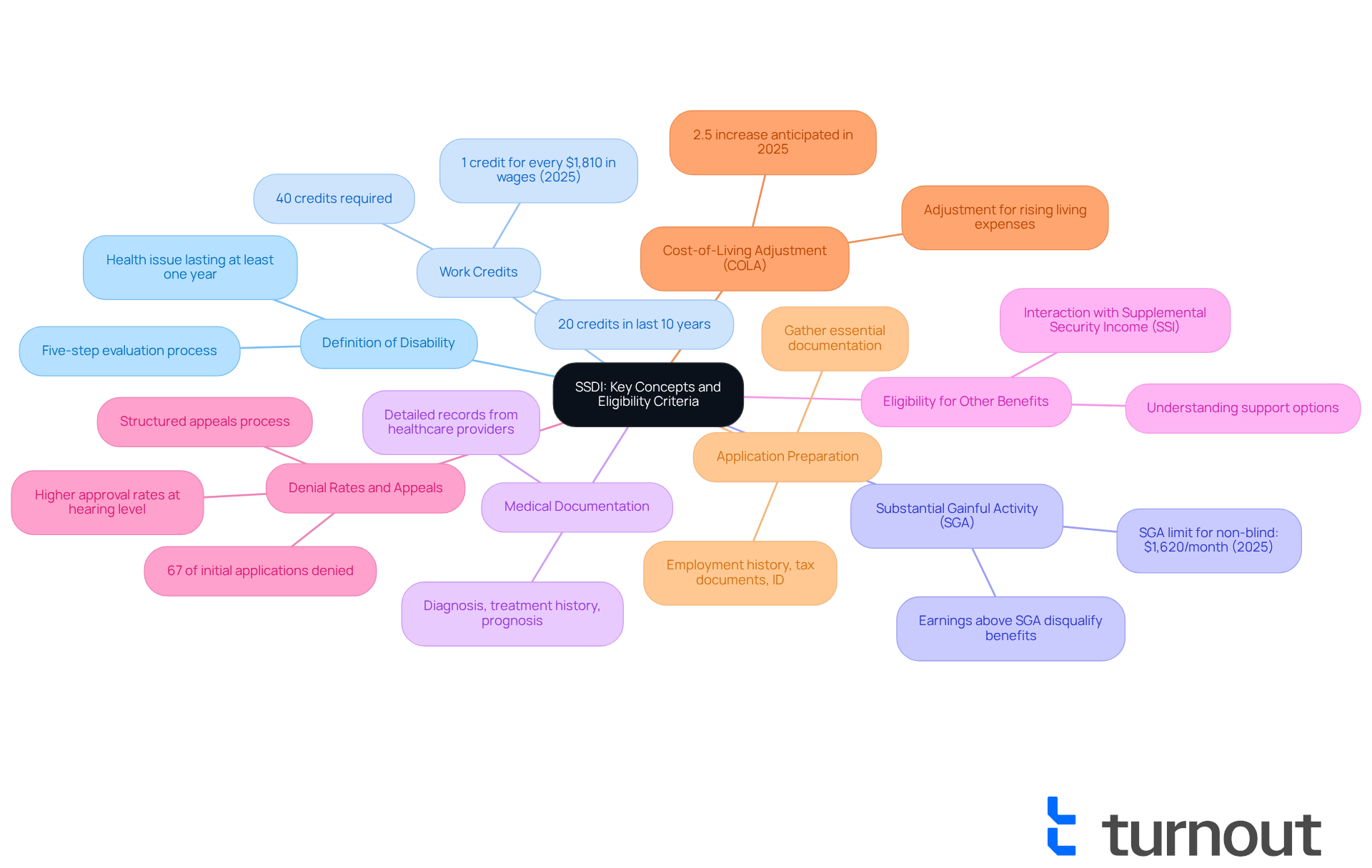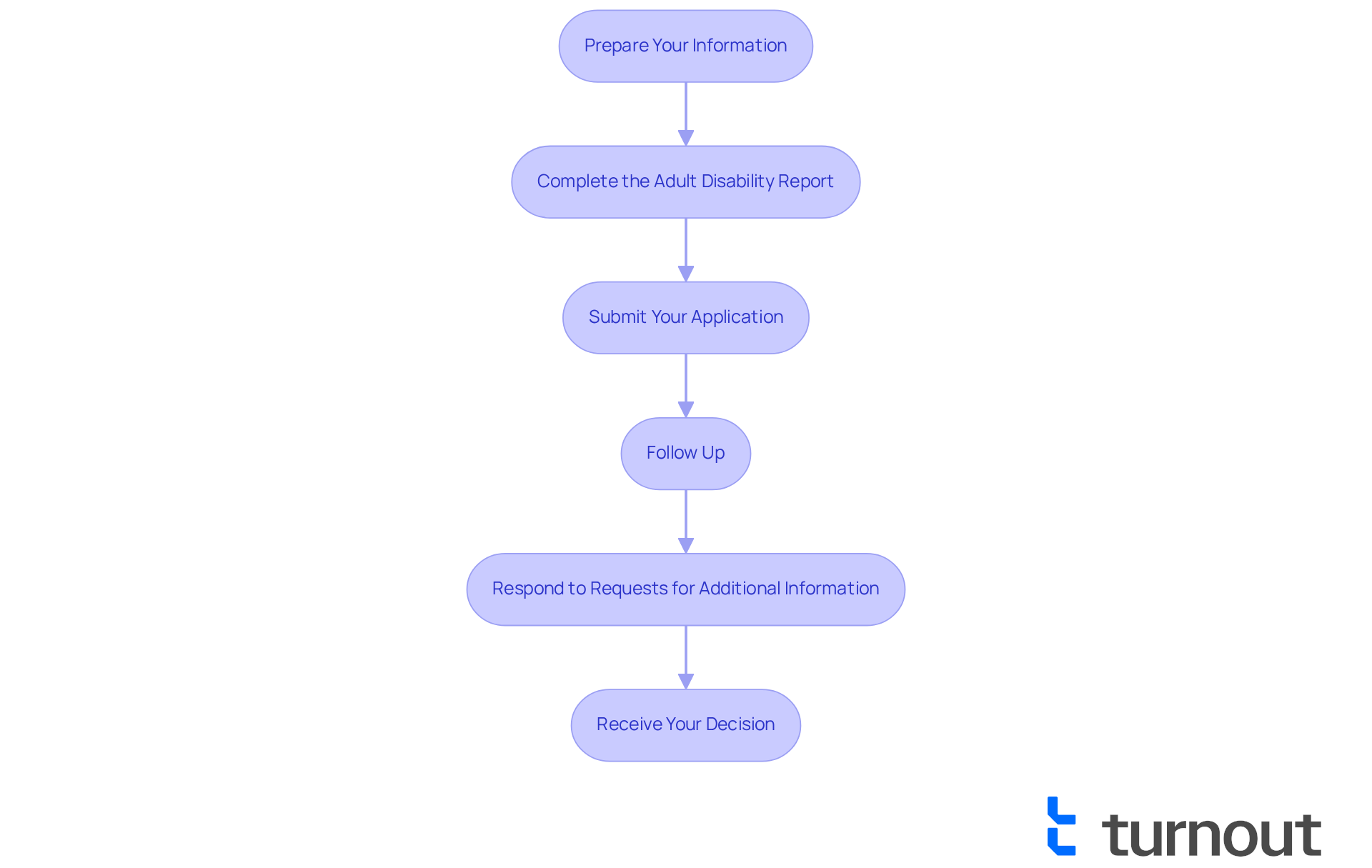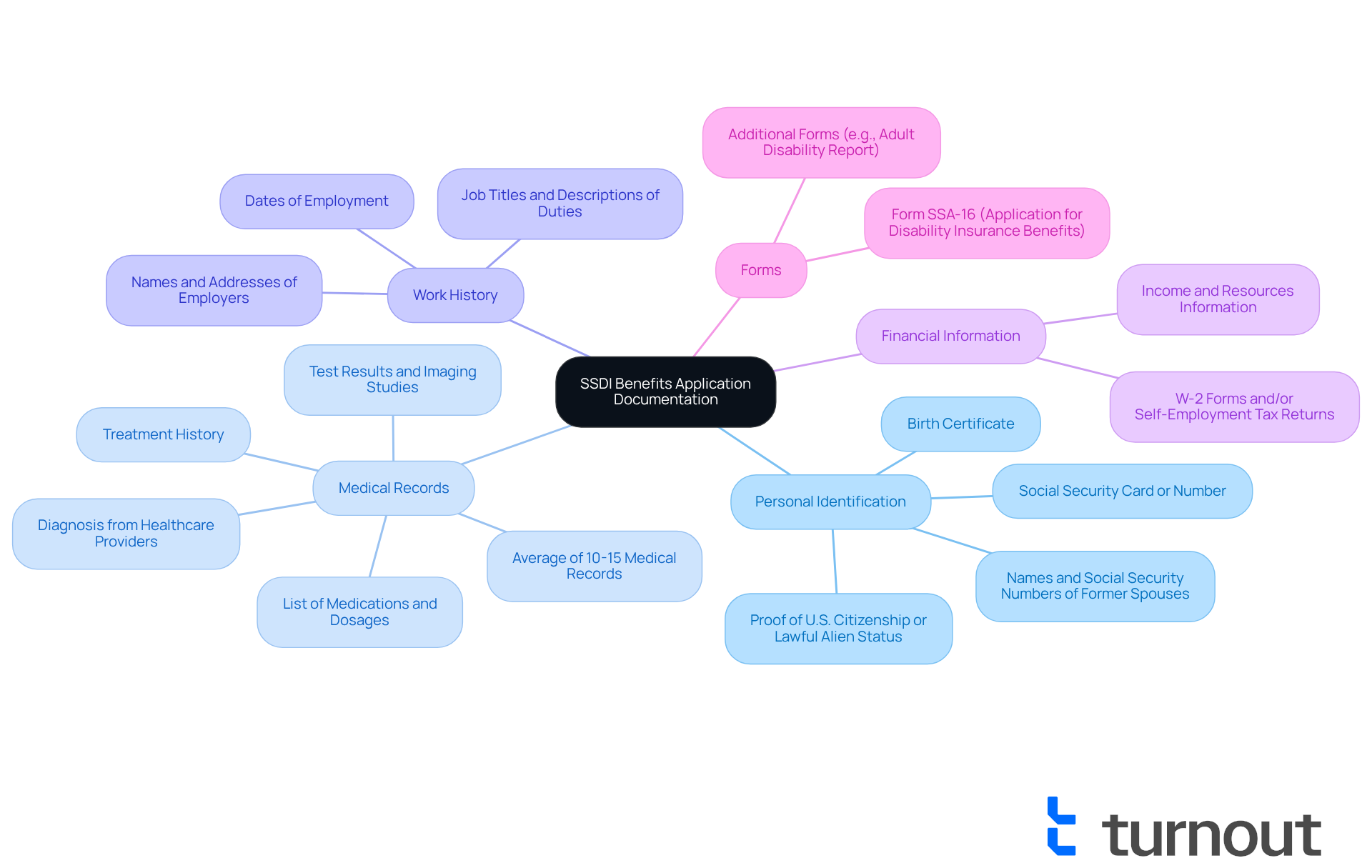Overview
This article serves as a compassionate guide to mastering the SSDI benefits application process. We understand that navigating this journey can be overwhelming, and we’re here to help you every step of the way. It outlines essential steps and the documentation needed for a successful submission, emphasizing the importance of thorough preparation and accurate information.
By utilizing resources like Turnout, you can find the support you need to navigate the complexities of the application. It's common to feel uncertain, but with the right tools and guidance, you can increase your likelihood of approval. Remember, you are not alone in this journey; we are committed to helping you succeed.
Introduction
Navigating the complexities of the Social Security Disability Insurance (SSDI) benefits application can feel overwhelming for many individuals facing health challenges. We understand that nearly two-thirds of initial applications are denied, making it essential to grasp the eligibility criteria and the application process for success. This guide serves as a comprehensive roadmap, equipping you with vital information and practical steps to enhance your chances of approval.
What are the common pitfalls to avoid?
How can you ensure that you present the strongest case possible?
You're not alone in this journey, and we're here to help.
Understand SSDI: Key Concepts and Eligibility Criteria
To qualify for Social Security Disability Insurance, understanding the specific criteria set by the Social Security Administration is essential for the SSDI benefits application. We know that navigating this process can feel overwhelming, so here are some key concepts to guide you:
- Definition of Disability: Social Security Disability Insurance is intended for individuals who cannot work due to a health issue that is expected to last at least one year or result in death. The SSA uses a five-step process in the ssdi benefits application to evaluate disability claims, ensuring that each case receives thorough attention.
- Work Credits: Accumulating sufficient work credits through your employment history is crucial. In 2025, you earn one credit for every $1,810 in wages, with a maximum of four credits per year. Generally, you will need a total of 40 credits, with at least 20 earned in the last 10 years before your disability began.
- Substantial Gainful Activity (SGA): For 2025, the SGA limit is $1,620 per month for non-blind individuals. Earning above this amount may disqualify you from receiving disability benefits, and we understand how important it is to stay informed about these thresholds.
- Providing comprehensive medical documentation is vital for your ssdi benefits application. This includes detailed records from healthcare providers that outline your diagnosis, treatment history, and prognosis. We know that gathering this information can be daunting, but it’s an important step in your journey.
- Eligibility for Other Benefits: Understanding how the ssdi benefits application interacts with other benefits, like Supplemental Security Income (SSI), is essential for optimizing your support options. You deserve to receive the assistance you need, and we’re here to help you navigate these complexities.
- Denial Rates and Appeals: It's important to note that nearly 67% of initial SSDI applications are denied nationwide. If your ssdi benefits application is denied, you can follow a structured appeals procedure, which provides you several opportunities to demonstrate your eligibility. Turnout offers assistance through trained non-legal advocates who can help you navigate this process effectively.
- Cost-of-Living Adjustment: In 2025, disability benefits are anticipated to increase due to a 2.5% cost-of-living adjustment (COLA). This adjustment helps ensure that your benefits keep pace with rising living expenses, which is crucial for your financial stability.
- Preparation for the ssdi benefits application requires gathering essential documentation, including medical records, your employment history for the last 15 years, tax documents, pay stubs, and personal identification. Turnout provides resources and support, including guidance from qualified non-professionals, to assist you in this preparation. We want to ensure you feel confident as you navigate the ssdi benefits application process.
By familiarizing yourself with these concepts and utilizing Turnout's resources, you can move through the submission system more efficiently and assess your eligibility with increased confidence. Remember, you are not alone in this journey; we are here to support you every step of the way.

Follow the Application Process: Step-by-Step Instructions
Navigating the ssdi benefits application procedure can feel overwhelming, but we're here to help. You can finalize your ssdi benefits application online, by phone, or in person. Here’s a step-by-step guide to support you through this journey:
- Prepare Your Information: Start by gathering essential personal information, including your Social Security number, contact details, and specifics about your medical condition. It’s important to have documentation ready, such as medical records and your work history.
- Complete the Adult Disability Report: This form is crucial as it collects vital information about your medical condition, work history, and education. Being thorough and precise is essential; it’s common for around 65-70% of initial SSDI submissions to be rejected due to incomplete information. You can find the report on the SSA website or at your local SSA office.
- Submit Your Application: You have options for applying: online at the SSA website, by calling to schedule an appointment, or by visiting your local office. Ensure all required documents are ready for submission. If you need assistance, Turnout offers support through trained non-legal advocates who can guide you through the submission process.
- Follow Up: After submitting your request, it's important to monitor your case status. You can check online or call the SSA for updates. Typically, the average wait time for a decision is between four to six months, but delays can happen based on your state and the complexity of your case. Additionally, be aware that there is a five-month waiting period before disability benefits begin after approval.
- Respond to Requests for Additional Information: The SSA may ask for further information or documentation. Responding promptly is crucial to avoid delays in processing. Remember, don’t hesitate to apply for the ssdi benefits application just because you don’t have all the documents; assistance is available through Turnout's resources to help you obtain them.
- Receive Your Decision: The SSA will notify you of their decision via mail. If approved, you will receive details about your benefits. If denied, know that you have the right to appeal the decision.
By following these steps and utilizing the support provided through Turnout, you can navigate the disability benefits request process more effectively, increasing your chances of a positive outcome. Ensure your medical records include diagnoses, provider names, tests, scans, lab results, a complete medication list, and treatment dates to strengthen your request. Remember, you are not alone in this journey; we are here to support you every step of the way.

Avoid Common Mistakes: Tips for a Successful Application
To enhance your chances of a successful SSDI benefits application, we understand that navigating the SSDI process can be daunting. Here are some helpful tips to avoid common mistakes:
- Be Thorough and Accurate: It's vital that all information in your submission is complete and precise. Incomplete submissions are often rejected. Remember, Turnout's trained non-professional advocates are here to help you evaluate your documents for completeness.
- Document All Medical Conditions: Include every relevant medical condition, even those that may seem minor. The SSA evaluates the totality of your health, and comprehensive documentation can significantly strengthen your case.
- Use Consistent Language: Ensure that the information you provide throughout your submission is consistent. Inconsistencies can raise red flags. Our representatives are ready to assist you in maintaining clarity and coherence.
- Submit All Required Documentation: Make sure to include all necessary medical records and supporting documents. Missing documents can delay the process or lead to denial. Turnout can guide you on what documents are essential for your SSDI benefits application.
- Avoid Exaggeration: It's important to be honest about your limitations and capabilities. Exaggerating your situation may lead to doubt from the SSA. Our team encourages honesty to build confidence in your submission.
- Apply Promptly: Don’t wait too long to apply after becoming disabled. The sooner you apply, the sooner you can receive benefits. Turnout is here to assist you throughout the submission process, ensuring you don’t miss important deadlines.
By being aware of these frequent errors and utilizing Turnout's resources, you can greatly enhance your submission’s chances of approval. Remember, you are not alone in this journey, and we’re here to help every step of the way.

Gather Required Documentation: Essential Forms and Evidence
When seeking the SSDI benefits application, we understand that collecting the necessary documents can feel overwhelming. However, gathering these documents is vital to efficiently strengthen your SSDI benefits application. Turnout offers resources and services to assist you in managing this intricate procedure without requiring legal representation. Please remember that Turnout is not a law firm and does not provide legal advice. Our trained nonlawyer advocates are here to support you throughout this process:
-
Personal Identification: It’s important to include your Social Security card or number, birth certificate, and proof of U.S. citizenship or lawful alien status. If applicable, please also provide the names and Social Security numbers of any former spouses.
-
Medical Records: Collecting all relevant medical documentation is crucial. This typically includes:
- Diagnosis from healthcare providers
- Treatment history
- Test results and imaging studies
- A list of medications and dosages
- On average, successful SSDI applications include around 10 to 15 medical records to substantiate the claim.
-
Work History: Providing a detailed work history is essential. Please include:
- Names and addresses of employers
- Dates of employment
- Job titles and descriptions of duties
-
Financial Information: Include information about your income and resources, as this may be relevant for determining eligibility. You should also provide W-2 forms and/or self-employment tax returns for the last year.
-
Form SSA-16: Complete the Application for Disability Insurance Benefits (Form SSA-16), which is available on the SSA website.
-
Additional Forms: Depending on your situation, you may need to complete other forms, such as the Adult Disability Report.
Collecting these documents beforehand can simplify the submission process for the SSDI benefits application and greatly lessen the chances of delays. It’s important to note that comprehensive documentation is essential for the SSDI benefits application; approximately 65-70% of initial submissions are rejected, often due to inadequate information or insufficient medical proof. Consequently, being thorough in gathering and displaying your medical documents is crucial for a successful SSDI benefits application. The procedure usually requires 3-5 months, making it essential to prepare appropriately. You can apply for disability benefits online, by phone, or in person at your local SSA office. Remember, Turnout's trained nonlawyer advocates are available to assist you throughout this process, ensuring you have the support needed to navigate your SSDI benefits application effectively. You are not alone in this journey.

Conclusion
Mastering the SSDI benefits application process is crucial for individuals seeking financial support due to disabilities. We understand that this journey can be overwhelming, but grasping the key concepts, eligibility criteria, and the step-by-step application process can significantly enhance your chances of a successful claim. With the right preparation and resources, you can navigate this complex system more efficiently and with greater confidence.
This article delves into essential aspects such as:
- The definition of disability
- The importance of work credits
- The need for thorough medical documentation
It highlights common pitfalls to avoid—like incomplete submissions and the necessity of timely applications. Remember, support is available through resources like Turnout, which offers guidance and assistance throughout your application journey.
Ultimately, the SSDI benefits application is not just a bureaucratic hurdle; it represents a lifeline for many individuals facing health challenges. By equipping yourself with the right knowledge and support, you can approach the process with renewed determination. Taking proactive steps and utilizing available resources can pave the way for securing the benefits that you rightfully deserve. You're not alone in this journey; we're here to help you every step of the way.
Frequently Asked Questions
What is Social Security Disability Insurance (SSDI)?
SSDI is a program intended for individuals who cannot work due to a health issue that is expected to last at least one year or result in death.
How does the Social Security Administration evaluate disability claims?
The SSA uses a five-step process to evaluate disability claims, ensuring that each case receives thorough attention during the SSDI benefits application.
What are work credits and how are they earned for SSDI eligibility?
Work credits are accumulated through your employment history. In 2025, you earn one credit for every $1,810 in wages, with a maximum of four credits per year. Generally, you will need a total of 40 credits, with at least 20 earned in the last 10 years before your disability began.
What is the Substantial Gainful Activity (SGA) limit for 2025?
For 2025, the SGA limit is $1,620 per month for non-blind individuals. Earning above this amount may disqualify you from receiving disability benefits.
What type of medical documentation is required for the SSDI application?
Comprehensive medical documentation is vital, including detailed records from healthcare providers that outline your diagnosis, treatment history, and prognosis.
How does SSDI interact with other benefits like Supplemental Security Income (SSI)?
Understanding the interaction between SSDI and other benefits like SSI is essential for optimizing your support options.
What are the denial rates for SSDI applications and what can be done if denied?
Nearly 67% of initial SSDI applications are denied nationwide. If your application is denied, you can follow a structured appeals procedure to demonstrate your eligibility.
What is the anticipated cost-of-living adjustment (COLA) for 2025 disability benefits?
In 2025, disability benefits are anticipated to increase due to a 2.5% cost-of-living adjustment (COLA), helping ensure that benefits keep pace with rising living expenses.
What documentation is needed to prepare for the SSDI benefits application?
Essential documentation includes medical records, your employment history for the last 15 years, tax documents, pay stubs, and personal identification.
How can Turnout assist individuals in the SSDI application process?
Turnout provides resources and support, including guidance from qualified non-professionals, to assist you in preparing for the SSDI benefits application and navigating the process confidently.




